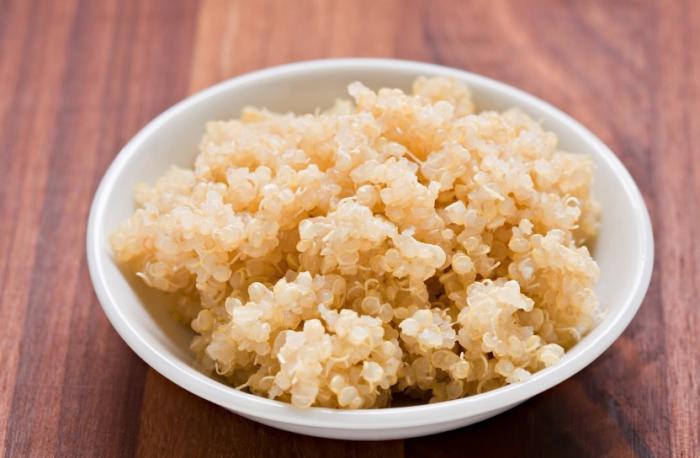Quinoa stands out for its important health benefits and properties, as it has vitamins, minerals and a high protein content. Discover its nutritional qualities and when it is not recommended to eat it.

The quinoa is similar to what we could understand as a cereal resembling in its composition and use of this type of food, although in this case belongs to the family of spinach. In fact, over the last few years it has become one of the most consumed cereals in half the world. But what properties does it have? Is it really as beneficial as they say? How can it be taken?
Although it is true that one of the most consumed cereals is corn thanks to the important benefits and properties of corn, quinoa can still be obtained without chemical alterations in health food stores.
Due to the outstanding benefits and properties of quinoa, this food is widely consumed in countries such as Peru, Argentina, Colombia, Ecuador, Chile or Bolivia.
Do you really know what quinoa is?
The Quinoa is a dry grain, which comes from a plant called quinoa. This plant is broad-leaved (pseudocereal) that belongs to the Chenopodioideae subfamily of the Amaranthaceae.
It is cultivated mainly in the Andes mountain range; this can be found in various typical dishes such as soups, coladas, in rice, in croquettes, stews, in salads, hamburgers, energy bars and in many other foods. It is a proper and useful food for a wide and healthy menu.
Despite not belonging to the family of cereals (since these do not grow on grasses), quinoa has a composition similar to these and can be cooked in the same way as cereals, since it is a pseudocereal.
Quinoa benefits
Quinoa seeds have a high protein value, vitamins C, E and group B, as well as an extremely interesting amount of dietary fiber, ideal precisely against constipation.
In certainly strict vegetarian diets, quinoa should not be lacking in this type of diet, as it helps to compensate for the lack of nutrients of animal origin such as milk or eggs.
It is also ideal for those people who currently follow a diet low in protein and who –in themselves- need a quick energy supply, at the same time that it can be consumed by the little ones during growth.
In addition, it is noteworthy that in quinoa we find amino acids such as tryptophan, methionine, cysteine, lysine and cystine, at the same time that it also has essential fatty acids.
We must not forget either their mineral content, since they offer appreciable amounts of iron, calcium and phosphorus.
Incredible properties of quinoa
As we have promised, we are going to talk about the properties that quinoa gives us in general and that give us a clue as to why it has become one of the most consumed foods in recent years:
- Great source of micronutrients. Quinoa is high in magnesium, calcium, phosphorus, iron and zinc while it also has vitamins of type B and E. Therefore, it goes without saying that it is one of the most complete cereals that exist.
- It does not contain gluten. Are you one of those celiac people who can’t take gluten? Well, you will have no problem consuming quinoa normally and in the amounts you deem appropriate.
- High content of natural fibers. Quinoa is recommended to all those who suffer from constipation from time to time. This is because this cereal has a high content of insoluble fibers that will favor our intestinal transit.
- A great source of energy. More and more athletes are taking quinoa before and after doing any exercise or sport. The reason? Well, because quinoa is an inexhaustible source of carbohydrates and proteins that provide extra energy that is sometimes so necessary when doing sports.
- It helps us lose weight. The caloric intake of quinoa is really low even when consumed in large quantities. Likewise, it also highlights the presence of Omega 6 and Omega3 acids that ultimately take care of our health and our line.
Nutritional qualities of quinoa
Dietary fiber
Fiber is the edible part of plants. This plant part is formed by a set of chemical compounds of a heterogeneous nature; the dietary fiber of quinoa has a list of different benefits, which are:
- Reduces constipation.
- Helps to treat obesity.
- Helps maintain a healthy colon.
- Helps improve glycemic control.
- It provides a lower absorption of cholesterol which is equivalent to a lower probability of suffering from conditions due to high levels of cholesterol and triglycerides in the blood.
Carbohydrates
Carbohydrates, also present in quinoa; they are biomolecules composed of carbon, hydrogen and oxygen. Its main function in living beings is to provide immediate and structural energy; these act as biological fuels and it is proposed that 60% of the daily energy that the body needs must come from carbohydrates.
The functions of carbohydrates in the body are as follows:
- Provide immediate energy to cells.
- They are responsible for maintaining the activity of the muscles.
- They are responsible for maintaining body temperature.
- They are responsible for maintaining the body’s blood pressure.
- They maintain the proper functioning of the intestine.
- They are responsible for the activity of neurons.
What is the most correct way to prepare quinoa?
Now that you have known all the benefits that quinoa gives us, it only remains that you begin to enjoy its rich flavor and texture. For this, first of all it is very important that you wash all the seeds very well, always rubbing them with your hands and under a strong stream of water.
In this way we get rid of the layers of saponins, a component that only adds a bitter taste to this cereal. Once this step is completed, then we will proceed to boil the quinoa in a good pot for about 15-20 min until the water is boiling.
After this, we remove all the water and we can enjoy all the benefits that quinoa offers in a healthy and natural way. The good thing about quinoa is that it can also be stored in the refrigerator without losing its properties. It is recommended to add a splash of olive oil and then put it in the microwave for a minute. This way you will enjoy its flavor again with little effort and without taking up a lot of time.
There are also other ways to cook quinoa through other foods such as chicken meats, clams or in a rich salad. As you have seen, there are many ways to enjoy all the benefits that quinoa offers.
Main contraindications of quinoa
Despite the wonderful benefits that quinoa gives us, the truth is that as with any other food, there are also a series of contraindications that we must take into account before consuming it? We discover below when it is not advisable to eat it:
- Intestinal problems: quinoa is a natural food with a high protein content. Therefore, its consumption is not recommended in people with intestinal problems, disorders or pathologies.
- Allergies: since it can cause allergies in some people, it is advisable to always try a small portion of quinoa before consuming it in normal quantities.
- Consumed in large quantities: it is not advisable to eat quinoa in high doses, since it contains a high amount of saponins, it can become a toxic food.































